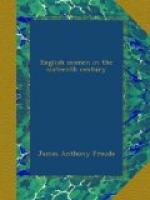Parsons describes his statement as a ’brief note on the present condition of England,’ from which may be inferred the ease and opportuneness of the holy enterprise. ‘England,’ he says, ’contains fifty-two counties, of which forty are well inclined to the Catholic faith. Heretics in these are few, and are hated by all ranks. The remaining twelve are infected more or less, but even in these the Catholics are in the majority. Divide England into three parts; two-thirds at least are Catholic at heart, though many conceal their convictions in fear of the Queen. English Catholics are of two sorts—one which makes an open profession regardless of consequences, the other believing at the bottom, but unwilling to risk life or fortune, and so submitting outwardly to the heretic laws, but as eager as the Catholic confessors for redemption from slavery.
‘The Queen and her party,’ he goes on, ’more fear these secret Catholics than those who wear their colours openly. The latter they can fine, disarm, and make innocuous. The others, being outwardly compliant, cannot be touched, nor can any precaution be taken against their rising when the day of divine vengeance shall arrive.
’The counties specially Catholic are the most warlike, and contain harbours and other conveniences for the landing of an invading army. The north towards the Scotch border has been trained in constant fighting. The Scotch nobles on the other side are Catholic and will lend their help. So will all Wales.
’The inhabitants of the midland and southern provinces, where the taint is deepest, are indolent and cowardly, and do not know what war means. The towns are more corrupt than the country districts. But the strength of England does not lie, as on the Continent, in towns and cities. The town population are merchants and craftsmen, rarely or never nobles or magnates.
’The nobility, who have the real power, reside with their retinues in castles scattered over the land. The wealthy yeomen are strong and honest, all attached to the ancient faith, and may be counted on when an attempt is made for the restoration of it. The knights and gentry are generally well affected also, and will be well to the front. Many of their sons are being now educated in our seminaries. Some are in exile, but all, whether at home or abroad, will be active on our side.




